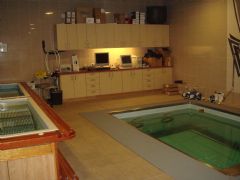The meeting went deep into the evening but there was still time to have a good catch up with the endurance guys (namely George Gandy, John Nuttall & Barry Fudge), the sprint guys (namely Tony Lester & Mike McFarlane, who were also joined by Jess Ennis' coach, Toni Minichiello) & the always entertaining double act of Fuzz Ahmed (National Jumps Coach) & Dr Rob Chakraverty. The topics of conversation were numerous but generally discussing how winter training had been going, who was showing indoor season promise & reaching the general consensus that Team GB has reason to be optimistic for the future, with some positive performances being laid down by some of the emerging talent in the ranks.
Of this emerging talent, many have enjoyed Futures funding status, which is awarded to young athletes fulfilling performance standards set by UKA, just as with the Development & Podium funding awards. The programme is currently directed by Jo Jennings & I head up the physiotherapy provision, in liaison with Dr Noel Pollock who provides the medical input.
This week I had meetings with two of this years Futures athletes & one of the topics that I was asked about was the use of ice baths. It's safe to say that cryotherapy is one of the most over-used, under-reasoned & subsequently misused recovery strategies in sport. The basic thinking is that by jumping in a tub of iced water after training, then the intensity of delayed onset muscle soreness is reduced & the subsequent reduction in muscle function is countered. However, the research shows that this theory, whilst holding some truth, comes at a cost.
My former lecturer at Loughborough, Dr David Bailey worked with my former colleague at the Football Association, Dr Sam Erith, to look at the effects of ice baths used in the recovery from an intermittent running exercise that resulted in exercise induced muscle soreness. They allowed the experimental group to spend ten minutes in a cold water immersion bath of 10 degrees C, whilst the control group just sat quietly for ten minutes. As expected, the subjects who participated in the cold water immersion recovery demonstrated decreased ratings of perceived muscle soreness, reduced decrements in maximum voluntary contraction & reduced levels of serum myoglobin post-exercise. So far, so good for those advocating the use of ice baths after training. The link to the reference for this paper is as follows:
Several weeks later, the same group then conducted a follow-up study to look at the effects on subsequent training bouts. By repeating the model of the initial study following a bout of exercise promoting exercise induced muscle soreness, they achieved similar results. However, they then waited a week & repeated the exercise bout but this time allowed neither group to recover using cold water immersion & what they found has significant implications for the use of ice baths in the training phase. The results showed that, after the second bout of exercise, the group that had performed cold water immersion after the initial exercise test demonstrated ratings of perceived muscle soreness, decrements in maximum voluntary contraction & levels of serum myoglobin post-exercise consistent to the those recorded on the control group of subjects following the initial bout. In contrast, the group that had initially acted as the control group, showed significantly lower ratings of perceived muscle soreness, decrements in maximum voluntary contraction & levels of serum myoglobin when the results were compared - ie, the group that hadn't had an ice bath had managed to adapt & gain some form of protection from the damaging effects of the exercise, whilst the adaptation had been blunted in the group that initially had had an ice bath.
To put that into context, by using ice baths in the training phase (ie pre-season, or off-season training), you risk actually blunting the training effects you are working so hard to achieve. However, once you have that protection, there is a reasoned argument for using ice baths in the recovery after competition, particularly in intense competition phases where there is minimal time to recover between bouts.
The other questions I was asked on the topic were "how long should I immerse myself for?" & "how cold should the water be?" & those are questions that the research has yet to answer sufficiently. A recent systematic review, conducted by Dr Chris Bleakley & Dr Suzanne McDonough (another one of my former lecturers) from the University of Ulster in Northern Ireland & published on the Cochrane Library on-line resource, failed to establish any definitive guidelines for the safe & effective use of ice baths in relation to these very questions. The authors stated further that there was also a lack of evidence detailing any potential harm that such practice could have, for example cold shock on the body.
To access the review, click on the link below:
So the conclusion to be drawn from this is: think what you are trying to achieve from your recovery strategies & seek out the information you need to ensure you understand the physiological impact of what you are actually doing.

